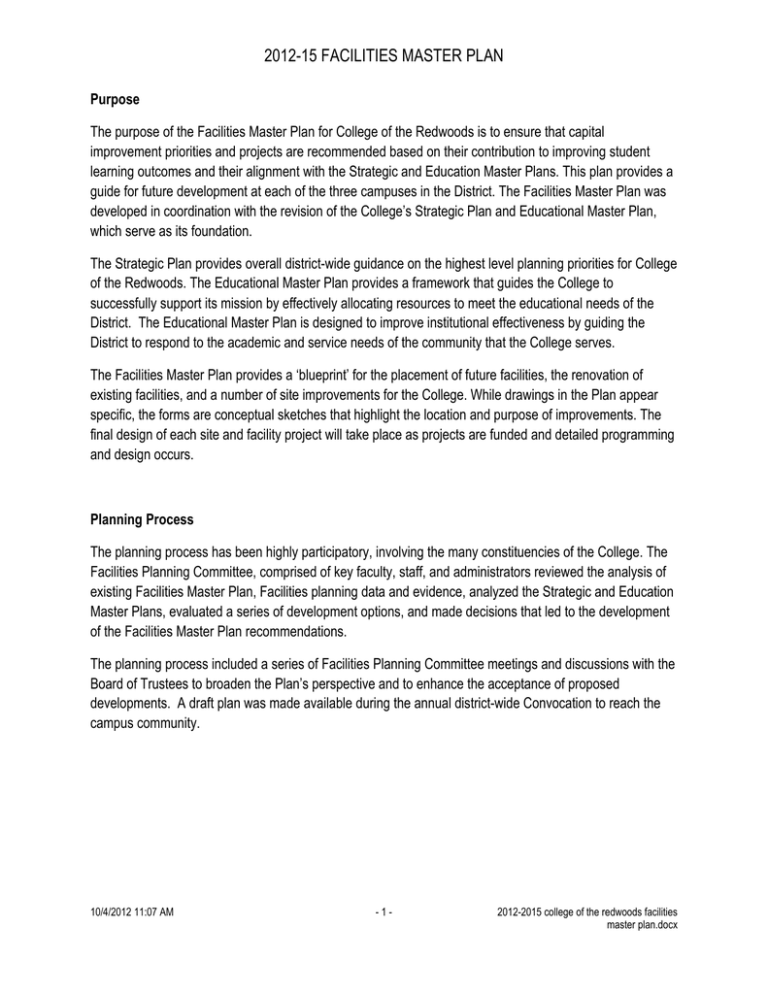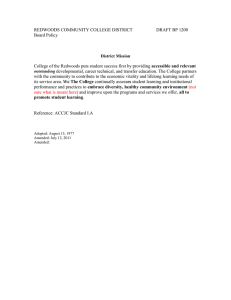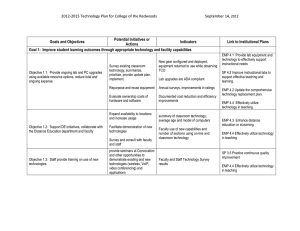2012-15 FACILITIES MASTER PLAN
advertisement

2012-15 FACILITIES MASTER PLAN Purpose The purpose of the Facilities Master Plan for College of the Redwoods is to ensure that capital improvement priorities and projects are recommended based on their contribution to improving student learning outcomes and their alignment with the Strategic and Education Master Plans. This plan provides a guide for future development at each of the three campuses in the District. The Facilities Master Plan was developed in coordination with the revision of the College’s Strategic Plan and Educational Master Plan, which serve as its foundation. The Strategic Plan provides overall district-wide guidance on the highest level planning priorities for College of the Redwoods. The Educational Master Plan provides a framework that guides the College to successfully support its mission by effectively allocating resources to meet the educational needs of the District. The Educational Master Plan is designed to improve institutional effectiveness by guiding the District to respond to the academic and service needs of the community that the College serves. The Facilities Master Plan provides a ‘blueprint’ for the placement of future facilities, the renovation of existing facilities, and a number of site improvements for the College. While drawings in the Plan appear specific, the forms are conceptual sketches that highlight the location and purpose of improvements. The final design of each site and facility project will take place as projects are funded and detailed programming and design occurs. Planning Process The planning process has been highly participatory, involving the many constituencies of the College. The Facilities Planning Committee, comprised of key faculty, staff, and administrators reviewed the analysis of existing Facilities Master Plan, Facilities planning data and evidence, analyzed the Strategic and Education Master Plans, evaluated a series of development options, and made decisions that led to the development of the Facilities Master Plan recommendations. The planning process included a series of Facilities Planning Committee meetings and discussions with the Board of Trustees to broaden the Plan’s perspective and to enhance the acceptance of proposed developments. A draft plan was made available during the annual district-wide Convocation to reach the campus community. 10/4/2012 11:07 AM -1- 2012-2015 college of the redwoods facilities master plan.docx 2012-15 FACILITIES MASTER PLAN Facilities Planning Priorities Building on the existing Facilities Master Plan, facilities planning data and evidence, analysis of the Strategic and Education Master Plans, evaluation of a series of development options, the following set of facilities planning priorities were developed: Student learning will be a visible priority in all practices and structures Facilities recommendations will be based on Educational Master Plan’s conservative growth projections Focus on maintaining and upgrading existing facilities before expanding Prioritize projects to support current and projected needs, given that CR currently has more facility space than is necessary As they reach end of life, replace portable buildings with permanent facilities, as funding allows Create flexible, interdisciplinary spaces to support a variety of activities Develop sites and facilities to attract students Develop student gathering areas (indoor and outdoor) Encourage students and community members to spend time on campus Incorporate sustainable design principles in all development Consider life cycle costs and reduce maintenance needs Incorporate total cost of ownership analysis into project design and consider designs that reduce operating costs Address ADA issues and reduce district liability Strategic Plan Goals The Board of Trustees approved the Strategic Plan goals on April 3, 2012. The Facilities Master Plan development process has been informed by the Strategic Plan goals. The Strategic Plan goals served as the basic parameters for the development of the educational planning recommendations which in turn guided the facilities planning efforts. The five Strategic Plan goals are summarized below: Goal 1 Focus on Learners: Developmental, Career Technical, and Transfer Education. College of the Redwoods will employ programs, services, and organizational structures to meet the needs of learners and ensure student success. Goal 2 Focus on Learners: Community Partnerships. College of the Redwoods will provide, in partnership with the community, training and education to contribute to the economic vitality and lifelong learning needs of the community. 10/4/2012 11:07 AM -2- 2012-2015 college of the redwoods facilities master plan.docx 2012-15 FACILITIES MASTER PLAN Goal 3 Fiscal and Operational Sustainability. College of the Redwoods will pursue strategies that lead to fiscal and operational sustainability. Goal 4 Technological Relevance. College of the Redwoods will develop infrastructure, adopt best practices, and conduct data analysis to utilize current and emerging technologies to support the learning environment and enhance institutional effectiveness. Goal 5 Enhance Institutional Profile. College of the Redwoods will engage in activities and initiatives to elevate the college’s profile in the community. Facilities Master Plan Goals The facilities planning priorities provided the parameters for the Facilities Planning Committee to develop the following list of goals that focus on district-wide site and facilities issues: Goal 1: Support Student Learning Outcomes Through Effective Allocation and Utilization of Facilities. Goal 2: Effectively Manage, Maintain, and Develop Facilities to Ensure Fiscal and Operational Sustainability. Goal 3: Promote Best Practices For Facility Sustainability, While Considering Total Cost of Ownership. Goal 4: Develop Facilities to Enhance the Learning Environment, Raise the Institutional Profile, and Enhance Community Connections. Sustainable Design Principles The Redwoods Community College District is committed to a policy of sustainable design, green building, and comprehensive energy efficiency and long term sustainability from a Total Cost of Ownership or (TCO) perspective. Integrating long term fiscal sustainability into capital improvement plans allows the Facilities Master Plan to provide a central framework for supporting this commitment. Each campus will apply a set of sustainable design principles to the TCO costing, siting, design, construction and commissioning of all master plan projects. 10/4/2012 11:07 AM -3- 2012-2015 college of the redwoods facilities master plan.docx 2012-15 FACILITIES MASTER PLAN Document Organization The Facilities Master Plan is comprised of this introductory, summary document and these three planning spreadsheet reports: 1. Review of existing Facilities Master Plan 2. Analysis of planning data and evidence 3. Review of revised Facilities Master Plan with clear linkages to institutional planning documents Closing the Loop The Facilities Master Plan will be referenced by the Facilities Planning Committee and the Budget Planning Committee when considering recommendations on facility projects. This Plan will be annually reviewed by the Facilities Planning Committee for potential adjustments and updates to maintain currency and will receive a major update at least every five years to maintain alignment with other planning documents, such as the Strategic Plan and Education Master Plan. Supporting documents The following documents were referenced during the planning process: Strategic Plan Educational Master Plan Technology Master Plan Five Year Construction Plan FUSION Data Facilities Planning Committee, Technology Planning Committee, Budget Planning Committee, Board of Trustees and other CR committee meeting agendas, minutes, and handouts 2008 Facilities Master Plan 2012-13 Statewide Five Year Capital Outlay Plan, located at: http://extranet.cccco.edu/Portals/1/CFFP/Facilities/Statewide_Plans/201314_5Yr_Capital_Outlay_Plan.pdf 10/4/2012 11:07 AM -4- 2012-2015 college of the redwoods facilities master plan.docx 2012‐15 College of the Redwoods FACILITIES MASTER PLAN Goals and Objectives Potential Initiatives or Actions Goal 1: Support Student Learning Outcomes Through Effective Allocation and Utilization of Facilities. Objective 1.1 Modernize existing facilities, maximize functional space and utilization rates. • Address ADA, and health & safety issues. • Provide basic renovations to facilities. • Create flexible, interdisciplinary spaces. • Address seismic concerns through facility repair or replacement. Indicator Link to Institutional Plans SP 1.6 Improve success among underrepresented populations. SP 3.2 Improve college operational efficiencies. • Amount of local bond funds spent addressing ADA and health & EMP 3.2 Student learning will be a visible priority in all practices safety issues, thereby reducing backlog of these issues. and structures. EMP 5.1 Improve student engagement among all students. SP 3.2 Improve college operational efficiencies. EMP 3.2 Student learning will be a visible priority in all practices and structures. EMP 5.1 Improve student engagement among all students. Objective 1.2 Eliminate non-functional space. • Remove temporary buildings. • Renovate or replace aging facilities. Objective 1.3 Develop sites and facilities to attract students. • Improve marquees and signage. • Upgrade lighting, painting, and technology. • Increase the visibility of student gov't and other student-related • Number of marquees and signs replaced. offices. • Find partners to occupy extra space. • Amount of extra space occupied by partners. • Modernize auxiliaries to enhance the student experience. • Increase in online student enrollments. • Develop facilities to support of online education to reduce pressure for new facilities and to serve students "where they are" instead of asking student to come to us. SP 1.4 Enhance student support and student engagement. SP 5.1 Enhance support for the college community. SP 5.3 Develop partnerships for utilization of the available buildings. EMP 4.3 Enhance distance education or eLearning. EMP 5.1 Improve student engagement among all students. EMP 5.2 Develop a vibrant student center. EMP 5.3 Increase student engagement in the community. • Upgrade completed at Mendocino. • Upgrades in process at Eureka and Del Norte. SP 1.3 Students will be able to complete their desired educational goals. SP 3.2 Improve college operational efficiencies. EMP 4.1.Provide lab equipment and technology to effectively support instructional needs. Objective 1.4 Update science labs. 10/4/2012 • Reduced reliance on temporary buildings. • Number of upgraded labs. 1 2012-2015 College of the Redwoods Facilities Master Plan .xlsx 2012‐15 College of the Redwoods FACILITIES MASTER PLAN Goals and Objectives Potential Initiatives or Actions Goal 2: Effectively Manage, Maintain, and Develop Facilities to Ensure Fiscal and Operational Sustainability. Indicator Link to Institutional Plans • Find partners to lease extra space. • Amount of extra space occupied by partners. • Focus District projects on improving long term sustainability and • Analysis of Total Cost of Ownership (TCO) in project requests. reducing TCO of existing facilities. SP 1.3 Students will be able to complete their desired educational goals. SP 3.2 Improve college operational efficiencies. EMP 3.4 Systematically use data to inform decision making. Objective 2.2 Align program investments and outcomes to long term funding. • Consolidate or combine related programs. • Maintain program competitiveness relative to CTE industry or community college peer data. • Increase distance learning and community education by improving technology and other infrastructure. • Number of program consolidations. • Increase in online student enrollments. SP 1.3 Students will be able to complete their desired educational goals. SP 2.1 Provide workforce development training. SP 3.1 Reduce reliance on apportionment-based funding. SP 3.2 Improve college operational efficiencies. SP 4.3 CTE programs will have technology relevant to their disciplines. EMP 2.1 Enhance community education program. EMP 4.3 Enhance distance education or eLearning. Objective 2.3 Improve efficiency while continuing to position the District to receive state funding. • Prioritize state bond project requests that address existing facility needs first. • Allocate local bond funds to maximize matching dollars. • Promote priorities and projects that result in lower total cost of ownership, encourage long term sustainability, and earn LEED, Energy Star or related sustainability recognition. • Provide for aggressive pursuit of matching dollars, rebates and incentives. • Amount of new state bond allocations. • Analysis of Total Cost of Ownership (TCO) in project requests. • Amount of Bond funds spent on energy efficiency. • Currently approved state infrastructure bond funding gets allocated to the District for projects. Objective 2.1 Base facilities recommendations on EMP growth projections and Chancellor's Office (CO) FTES funding caps. 10/4/2012 2 SP 3.1 Reduce reliance on apportionment-based funding. SP 3.3 Increase funding available for strategic initiatives. EMP 3.4 Systematically use data to inform decision making. 2012-2015 College of the Redwoods Facilities Master Plan .xlsx 2012‐15 College of the Redwoods FACILITIES MASTER PLAN Goals and Objectives Potential Initiatives or Actions Goal 3: Promote Best Practices For Facility Sustainability , While Considering Total Cost of Ownership. Incorporate a bulleted list of themes into all contracts with architects and planners: • Make and document decisions that enhance the student Objective 3.1 Prioritize the enhancement of the student learning learning environment at every step of the project from initial environment in all capital outlay projects. planning to final project closeout. • Incorporate student learning oriented best practices in facility projects as supported by evidence. Indicator • District adopts a practice of incorporating a bulleted list of Sustainability and TCO Themes into all contracts with architects and planners. Link to Institutional Plans SP 1.4 Enhance student support and student engagement. SP 3.1 Reduce reliance on apportionment-based funding. SP 3.2 Improve college operational efficiencies. EMP 5.2 Develop a vibrant student center. Objective 3.2 Incorporate sustainable design principles in all development. Minimize the negative long-term effect on the environment. Incorporate a bulleted list of Themes into all contracts with architects and planners: • Provide long term sustainability driven by lowest total cost of ownership. • Obtain LEED and/or Energy Star certifications or conform plans • District adopts a practice of incorporating a bulleted list of to meet those specifications. Sustainability and TCO Themes into all contracts with architects • Address program needs. and planners. • Maximize reuse of existing facilities, furniture, equipment, and technology and use renewable resources. • Encourage sustainable behaviors, for example bike racks, bus shelters, low flow toilets, passive lighting, reduced waste stream, reduced noise & light pollution, etc. SP 3.1 Reduce reliance on apportionment-based funding. SP 3.2 Improve college operational efficiencies. EMP 5.2 Develop a vibrant student center. Objective 3.3 Consider life cycle costs and reduce maintenance needs. Incorporate a bulleted list of Themes into all contracts with architects and planners: • Facility design driven by lowest total cost of ownership. • Conform ADA plans to current codes. • Maximize energy efficiency. • Obtain comprehensive, multiyear warranties for all materials and labor provided. SP 3.1 Reduce reliance on apportionment-based funding. SP 3.2 Improve college operational efficiencies. EMP 5.2 Develop a vibrant student center. 10/4/2012 • District adopts a practice of incorporating a bulleted list of Sustainability and TCO Themes into all contracts with architects and planners. 3 2012-2015 College of the Redwoods Facilities Master Plan .xlsx 2012‐15 College of the Redwoods FACILITIES MASTER PLAN Goals and Objectives Potential Initiatives or Actions Goal 4: Develop Facilities to Enhance the Learning Environment, Raise the Institutional Profile, and Enhance Community Connections. Indicator Link to Institutional Plans Objective 4.1 Modernize the District's auxiliary and community facilities. • Renovate existing residence halls, dining hall, bookstore, and community facilities to address basic maintenance needs Districtwide. • Reconfigure residence halls to promote a collaborative learning environment. • Enhance stadium and fields and gym to attract youth, K-12 and community partners. • Capital outlay dollars spent on auxiliary and recreational facilities, with a reasonable split between District centers and sites. • Increased partnerships for auxiliary facilities. SP 3.1 Reduce reliance on apportionment-based funding. SP 3.2 Improve college operational efficiencies. EMP 5.2 Develop a vibrant student center. Objective 4.2 Install a sewer main to eliminate on-site waste treatment plant. • Partner with regional wastewater district to install several miles of sewer main to service the Eureka campus and communities in between. • Eliminate the on-site waste treatment which is uncommon among California's community colleges. • Eliminate on-site waste water treatment which results in higher operating costs and increased risk of a waste spill. • Capital outlay dollars spent on sewer main. • Cooperation among many community partners. • Identification of an outside funding source and analysis of revenue streams and TCO in support of the project. SP 3.1 Reduce reliance on apportionment-based funding. SP 3.2 Improve college operational efficiencies. SP 3.3 Increase funding available for strategic initiatives. SP 3.4 Increase community support for the college. SP 5.1 Enhance support for the college community. SP 5.7 Increase public support for the college. Abbreviations: ADA: Americans With Disabilities Act CO: Chancellor's Office CTE: Career and Technical Education EMP: Education Master Plan LEED: Leadership in Energy and Environmental Design SP: Strategic Plan TCO: Total Cost of Ownership 10/4/2012 4 2012-2015 College of the Redwoods Facilities Master Plan .xlsx


